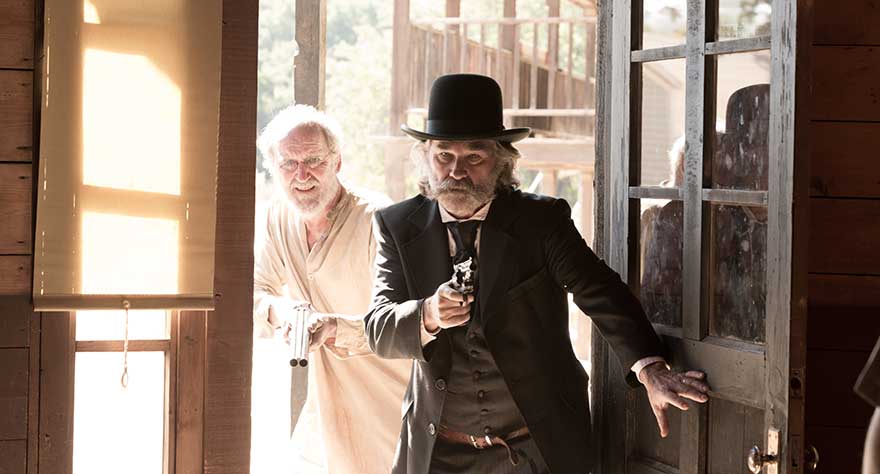
A surprising horror/western mash-up with a terrific cast, 'Bone Tomahawk' is an impressive debut.

A surprising horror/western mash-up with a terrific cast, 'Bone Tomahawk' is an impressive debut.
In the arid landscape of derivative and unoriginal horror movies, the sight of something different can act like discovering a wellspring. Saying that S. Craig Zahler’s Bone Tomahawk is a wholly original film would be disingenuous. Zahler hasn’t created something new so much as re-arranged what’s already there into a beguiling and (eventually) nasty combination. First and foremost a western, Bone Tomahawk teases its gradual turn to the sadistic and bloody with its opening sequence before settling into its own unique groove. If anything, Zahler has immediately established himself as one to watch in genre filmmaking right now by creating something no one else is doing right now.
The aforementioned opening finds murderers/thieves Purvis (David Arquette) and Buddy (Sid Haig) stumbling on (and desecrating) the burial ground of a group of cave-dwelling cannibals. Cut to 11 days later, where Purvis takes shelter in the small town of Bright Hope, only to get arrested by Sheriff Hunt (Kurt Russell) and his deputy Chicory (Richard Jenkins). But Purvis isn’t aware that the cave dwellers have been tracking him, and overnight they kidnap Purvis, Deputy Nick (Evan Jonigkeit) and town doctor Samantha (Lili Simmons). Hunt and Chicory decide to head out on a rescue mission to bring back Nick and Samantha, bringing two more townsmen with them: Samantha’s husband Arthur (Patrick Wilson), recovering from a broken leg, and Brooder (Matthew Fox), a handsome gunslinger who claims to have killed more Indians than anyone else in town.
Not that the villains in Bone Tomahawk are Indians, as Zahler is quick to point out through a Native American character who refers to them as “troglodytes.” It might be easy to label the film as a revisionist western given its realism and subversion of genre clichés but, for the most part, it feels like Zahler is just creating his own strange universe within the Wild West. This extends to Zahler’s screenplay, which revels in stylized dialogue that will have fans of Deadwood feeling nostalgic (in this film, “Can you be quiet?” becomes “Is it possible for you to close that aperture?”). Zahler, a novelist making his directorial debut here, has a great sense of humour too, giving his cast plenty of opportunities to revel in his script’s seemingly endless turns of phrase.
It also helps that Zahler has assembled a seriously impressive cast for his first feature. The presence of a familiar face like Kurt Russell as Sheriff Hunt elevates the character significantly, along with the inclusion of character actors in every other major role. Matthew Fox plays directly against type as the ruthlessly pragmatic and vain Brooder, but he sells the role perfectly, looking like he’s thriving on the chance to show off a side of himself that hasn’t really been given the opportunity to shine before. At first, Patrick Wilson looks typecast as yet another portrait of wounded masculinity (this time in a more literal sense), but his casting feels like a subversion of Wilson’s previous roles once he completes his character’s arc. It’s the best role Wilson has had in years, but if an MVP had to be selected out of the cast it would have to be Richard Jenkins. He’s almost unrecognizable as the bearded, oafish Chicory, providing both the comedic relief for the film along with its beating heart once more details emerge about his past. It’s bound to go down as one of the year’s most underrated performances.
But the most surprising thing about Bone Tomahawk isn’t its screenplay or its merging of two genres that usually stay separate; it’s the film’s breathing room that helps the film stand on its own. The 132-minute runtime is a rare sight these days for a low-budget (under $2 million to be precise, an astonishing figure given how good the movie looks) genre movie, but Zahler’s writing skills and his cast make it hard to find a single dull moment. Each scene, no matter how much it might feel like a total non-sequitur or detour from the main narrative, always keeps the focus on character. And, admittedly, this makes the final act’s sudden shift into the grotesque all the more impactful. The less said about Bone Tomahawk’s horror elements the better (it’s best to watch it unfold without knowing anything), but its drastic turn into a bloody gorefest certainly leaves an impression with one of the most brutal death scenes ever put in a film. And Zahler shows his skills as a filmmaker by having this tonal shift work, using the strength of his characters to carry along the change in circumstances. Zahler’s curious approach might not work all the time, and the meshing of two disparate genres doesn’t always come together nicely, but it makes for a fascinating and (mostly) entertaining experience.